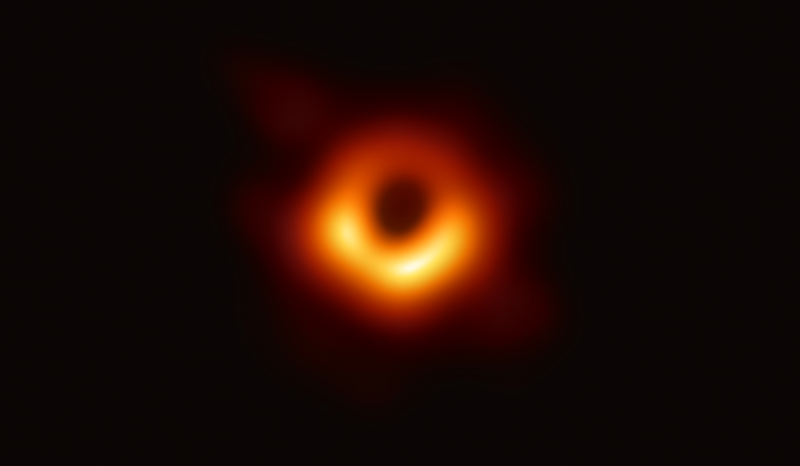They’re in every book ever written about space, in every science fiction film: black holes. They are areas in space where gravity is so strong that natural laws no longer apply and that neither, radiation, nor light can escape from.
They’re so ubiquitous that you’d be forgiven for not knowing that until Wednesday, black holes were still theoretical. There was plenty of evidence for them, but no one had ever actually seen one.
To be fair, that was pretty much impossible: black holes may be enormous, but trying to find one is sort of like trying to find a beer coaster on earth when you’re standing on the moon. For a proper picture of a black hole you’d need a telescope the size of our entire planet.
Clever plan
But then Dutch astronomer Heino Falcke and American scientists Shep Doeleman came up with a clever plan: what if you took the signals from telescopes from all over the world and combined them into a single observation?
Thus was created the Event Horizon Telescope (EHT). Eight telescopes, in locations ranging from the South Pole to Chile, from Arizona to Spain and Hawaii were all aimed at Sagittarius A*, the black hole at the centre of our very own Milky Way, as well as Messier 87, a black hole one galaxy over.
It’s not unlike what they’re doing with the radio telescopes at Westerbork, whose signals are being combined to show large parts of the night sky.
Huge undertaking
‘It’s a huge undertaking’, says Ronald Hesper with the Kapteyn Institute. ‘There are only a few days a year when all these different telescopes from all over the world can see these black holes at the same time. And the signals from the different telescopes aren’t even compatible.’
To combine the signals, they needed a block downconverter, a device in the telescope that is connected in series, uniting the signals from the various telescopes.
‘MIT had made one’, says Hesper, ‘but that one wasn’t quite finished yet. They wanted to make six for the industry, but that was much too expensive.’
Receivers
In 2014, Hesper was approached by EHT’s project manager. Because they created the receivers for the Chilean ALMA telescope, the Kapteyn Institute has experience with high-frequency equipment that’s connected in series.
‘But the controls had quite a few bugs’, Hesper recalls. ‘We got a lot of interference signals.’
Together with technician Rob de Haan, Hesper spent most of his evenings making the six converters. A year later, when the project was expanded, they made another six. ‘And because I had complained about everything that was wrong with them, they were like, “So fix it!”‘
He debugged the controls, filtered out the interference, and improved the overall design. The perfect circumstances finally occurred in 2017: ‘It was bizarre. The weather was great at literally every single telescope location’, he says. ‘That almost never happens!’
Problems
The observation nearly didn’t happen, though. Several hours before it was scheduled to start, Hesper, who was on standby in case there were any problems with ‘his’ converters, received a phone call from the telescope centre in Arizona at four in the morning. ‘They said it wasn’t working.’
Hesper was tasked with debugging the device over the phone and through Skype. ‘Like trying to troubleshoot what’s wrong with your mother’s computer over the phone’, he says.
The next few hours were extremely tense. ‘We fixed the problem seven minutes before the observation was taking place. They put on the lid, put it back into the telescope and just went for it!’
The next year, during the scheduled observations in 2018, everything that had gone so well the previous year went wrong. ‘In Chile, ALMA had a power outage for the first time in years. The weather in Hawaii was terrible. There were such strong winds in Granada that they couldn’t even turn on their telescopes, and the telescope in Mexico had been attacked by a drug cartel.’
Six square metres
The observations from 2017, stored on six square metres of hard drives since it was too much data to send over the internet, had been sent to various scientific consortiums. They were studied for a whole year, and on Wednesday, the results were unveiled: a picture of a black spot surrounded by a vortex of light and radiation. ‘It’s like looking at the gates of hell’, said Falcke during the press conference. ‘To the end of space and time.’
Interestingly enough, the picture isn’t of ‘our’ black hole Sagittarius A*, but of the M87 black hole. ‘The debris disk that surrounds black holes caused too much interference’, says Hesper. ‘Plus, the situation kept changing.’
The M87 black hole was much ‘calmer’. It’s also much bigger, which means any changes in its surroundings were happening at a slower rate.
Hesper watched the announcement of the black hole picture with his Kapteyn Institute, through a live stream. ‘I’m just a small cog in the system, but I am an essential cog, which means I am part of the whole process’, he says. ‘That’s pretty special.’




